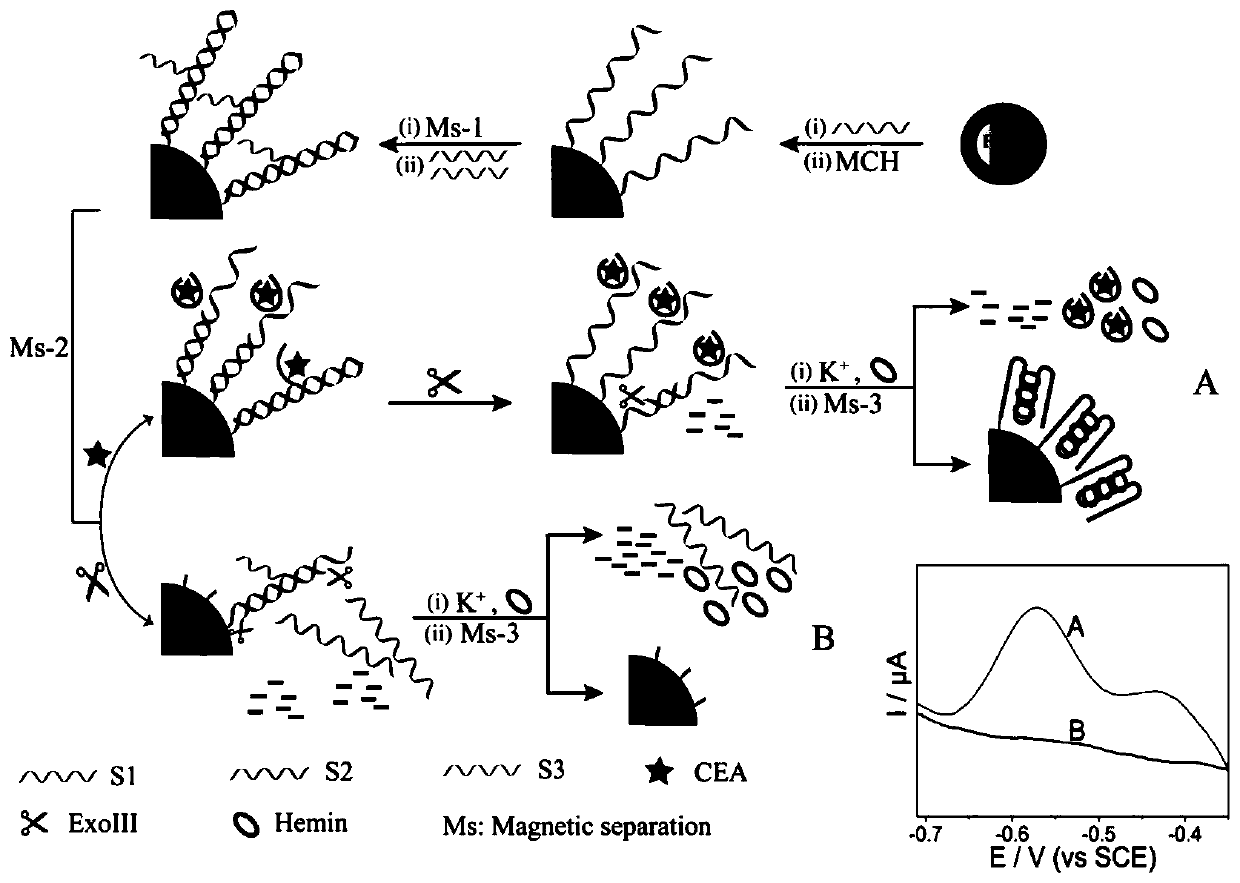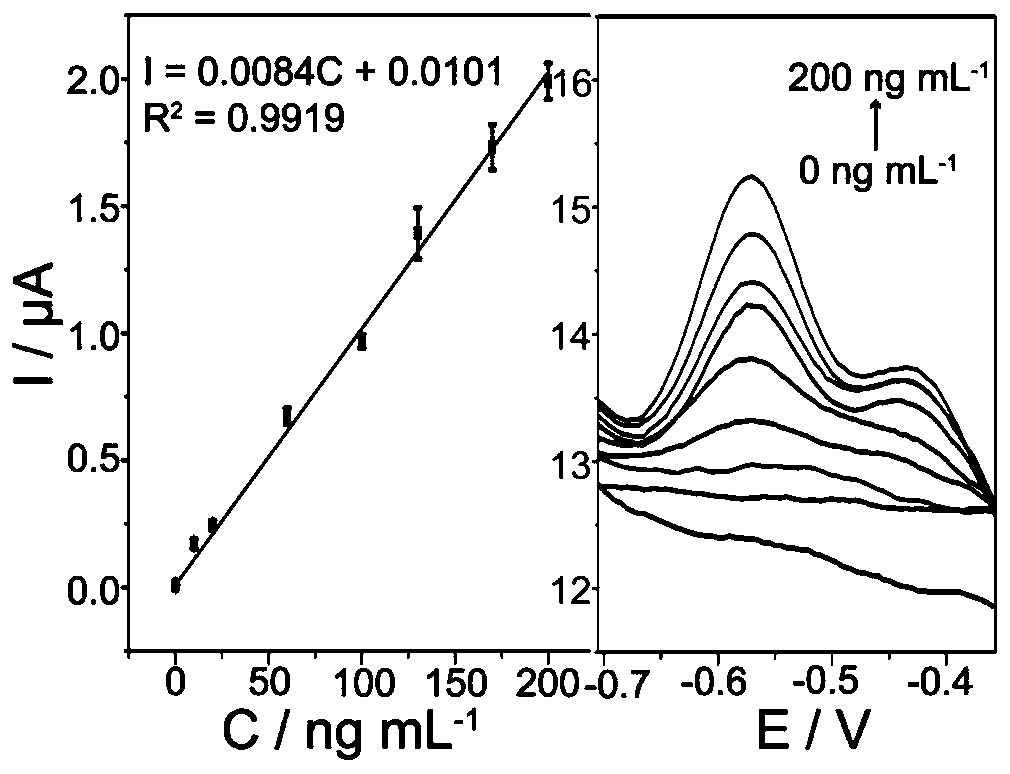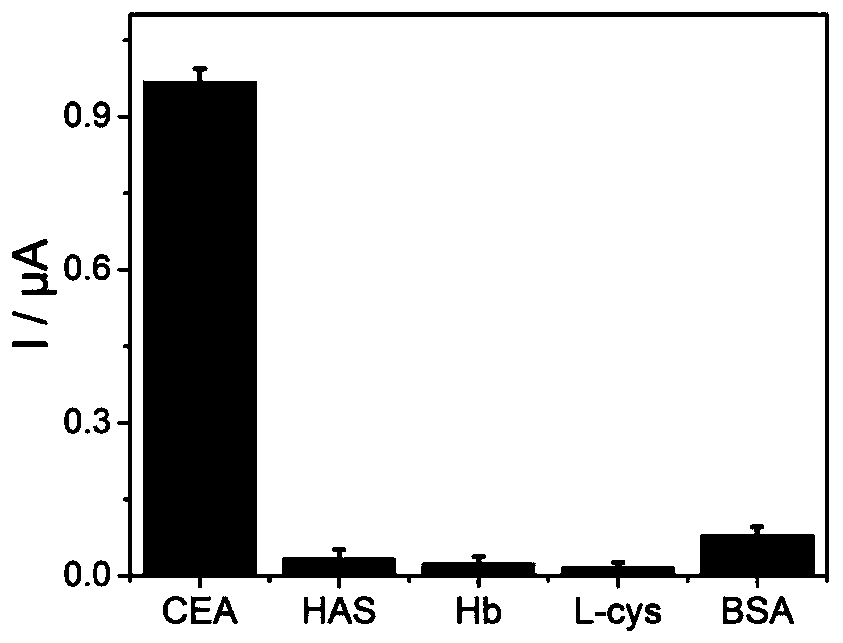Carcino-embryonic antigen electrochemical sensor constructed from magnetic material and exonuclease III
A technology of exonuclease and carcinoembryonic antigen, applied in the field of analysis and detection, can solve the problems of cumbersome process, high cost, complex electrode modification, etc.
- Summary
- Abstract
- Description
- Claims
- Application Information
AI Technical Summary
Problems solved by technology
Method used
Image
Examples
Embodiment 1
[0043] A method for detecting carcinoembryonic antigen with a carcinoembryonic antigen electrochemical sensor constructed by magnetic materials and exonuclease III, the steps are:
[0044] a) Construction of magnetic biocomposite material Fe 3 o 4 @Au NPs-S1-S2-S3: First modify S1 to Fe 3 o 4 On @Au nanoparticles, the final concentration of S1 in the reaction system is 0.1 μM, Fe 3 o 4 The final concentration of @Au nanoparticles in the reaction system is 0.2g L -1 , and then the Fe modified with S1 3 o 4 @Au nanoparticles were co-incubated with the carcinoembryonic antigen aptamer S2 and the complementary sequence S3 of the G-rich sequence at 37°C for 120 min to construct the magnetic biocomposite Fe 3 o 4 @Au NPs-S1-S2-S3; the concentration ratio of S1 to S2 and S3 is 1:1:1; the Fe 3 o 4 @Au nanoparticles are made of Fe 3 o 4 Nanoparticles with HAuCl 4 According to the mass ratio of 1:6 synthesis;
[0045] Modification of S1 to magnetic Fe as described above 3...
Embodiment 2
[0052] A method for detecting carcinoembryonic antigen with a carcinoembryonic antigen electrochemical sensor constructed by magnetic materials and exonuclease III, the steps are:
[0053] a) Construction of magnetic biocomposite material Fe 3 o 4 @Au NPs-S1-S2-S3: first modify S1 onto magnetic Fe3O4@Au nanoparticles, the final concentration of S1 in the reaction system is 1.0 μM, Fe 3 o 4 The final concentration of @Au nanoparticles in the reaction system is 0.8g L -1 , and then the Fe modified with S1 3 o 4 @Au nanoparticles were co-incubated with the carcinoembryonic antigen aptamer S2 and the complementary sequence S3 of the G-rich sequence at 37°C for 150 min to construct the magnetic biocomposite material Fe 3 o 4 @Au NPs-S1-S2-S3; the concentration ratio of S1 to S2 and S3 is 1:1:1; the Fe 3 o 4 @Au nanoparticles are made of Fe 3 o 4 Nanoparticles with HAuCl 4 According to the mass ratio of 1:3 synthesis;
[0054] Modification of S1 to magnetic Fe as describ...
Embodiment 3
[0061] A method for detecting carcinoembryonic antigen with a carcinoembryonic antigen electrochemical sensor constructed by magnetic materials and exonuclease III, the steps are:
[0062] a) Construction of magnetic biocomposite material Fe 3 o 4 @Au NPs-S1-S2-S3: first modify S1 to magnetic Fe 3 o 4 On @Au nanoparticles, the final concentration of S1 in the reaction system is 0.5 μM, Fe 3 o 4 The final concentration of @Au nanoparticles in the reaction system is 0.5g L -1 , and then co-incubated the Fe3O4@Au nanoparticles modified with S1 with the carcinoembryonic antigen aptamer S2 and the complementary sequence S3 of the G-rich sequence at 30 °C for 30 min to construct the magnetic biocomposite material Fe 3 o 4 @Au NPs-S1-S2-S3; the concentration ratio of S1 to S2 and S3 is 1:1:1; the Fe 3 o 4 @Au nanoparticles are made of Fe 3 o 4 Nanoparticles with HAuCl 4 According to the mass ratio of 1:7 synthesis;
[0063] Modification of S1 to magnetic Fe as described a...
PUM
 Login to View More
Login to View More Abstract
Description
Claims
Application Information
 Login to View More
Login to View More - R&D
- Intellectual Property
- Life Sciences
- Materials
- Tech Scout
- Unparalleled Data Quality
- Higher Quality Content
- 60% Fewer Hallucinations
Browse by: Latest US Patents, China's latest patents, Technical Efficacy Thesaurus, Application Domain, Technology Topic, Popular Technical Reports.
© 2025 PatSnap. All rights reserved.Legal|Privacy policy|Modern Slavery Act Transparency Statement|Sitemap|About US| Contact US: help@patsnap.com



